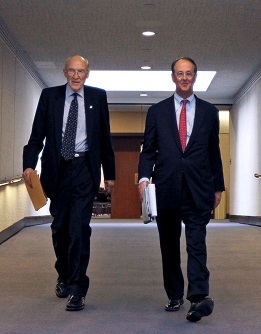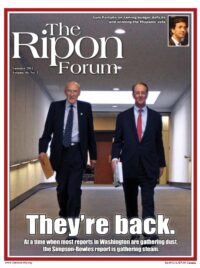
When the President announced the creation of the National Commission on Fiscal Responsibility and Reform in February of 2010, the debt was an issue that was barely on the radar screen.
The Commission was created with little fanfare and low expectations about what it could accomplish. Although I joined the staff of the Fiscal Commission with the optimism befitting the Chicago Cubs fan that I am, my twenty years of experience working on fiscal policy as a Congressional staffer told me that the prospects for success were about the same as a World Championship for the Cubs.
Yet not only did the Commission put forward a plan taking bold steps to reduce the deficit by $4 trillion over the next decade that won the support of 11 out of 18 of our commissioners – 5 Republicans, 5 Democrats, and 1 Independent – it helped elevate the national debt to the top of the national agenda. The Simpson-Bowles plan outlined in the report has become the “gold standard” for fiscal plans and is widely cited by policymakers, business leaders, press and the public as the model for what needs to be done. (For the plan’s key highlights, see below.)
How did a Commission that was given so little chance of success come to have such an impact on the policy debate in Washington and across the country? There are many answers to that question, including a much greater awareness and concern about the deficit, but the reason that the plan has had such staying power is that it responds to the public desire for leaders in Washington to rise above petty politics to come together to reach principled compromises on the challenges facing the nation. Above all, they want their leaders to put the national interest ahead of partisan interests and special interests.
…the reason that the plan has had such staying power is that it responds to the public desire for leaders in Washington to rise above petty politics to come together to reach principled compromises on the challenges facing the nation.
It is true that many people and even lawmakers who express support for the Simpson-Bowles plan don’t know everything that is in the plan. But they know that it is a plan big enough to actually solve the problem, that it takes on sacred cows across the budget and asks everyone to contribute to the solution and that it is a bipartisan plan that provides a path to actually get something done.
As I have worked with Al Simpson and Erskine Bowles over the last two years talking about the plan I have heard a consistent refrain from people expressing appreciation for their work – the Simpson-Bowles plan may not be their ideal approach to dealing with the debt and they don’t like everything in it but they recognize that this is a problem that needs to be addressed and that solving it will require everyone to accept things they don’t like.
The report, entitled “The Moment of Truth,” laid out for the public and policymakers the magnitude of the problem, the urgency of action to deal with it, and the tough choices that will be necessary in simple, stark language. The report put forward a comprehensive fiscal plan that included over sixty specific recommendations for reforms of spending programs and the tax code. But more important than any of the specific options in the plan is that the Commission’s report laid the foundation for an honest dialogue about the tough choices and tradeoffs that will be necessary to establish a framework for moving forward. It turns out that the frank conversation about what will truly be needed to deal with the debt that politicians have been afraid to have with their constituents is exactly what people want. As Commission Co-chairman Alan Simpson has said, the public is thirsting for leaders to tell the truth.
One of the biggest lessons from the experience of the Commission is that a proposal to deal with the debt needs to be big and comprehensive in order to succeed politically. When Simpson and Bowles put forward their co-chairmen’s proposal to the rest of the commission, Washington insiders were shocked that the plan so aggressively exceeded our mandate. They were sure that the proposal would need to be scaled back to get a majority vote. Indeed, even among commission staff we had started thinking about ways the plan could be softened to get more support.
One of the biggest lessons from the experience of the Commission is that a proposal to deal with the debt needs to be big and comprehensive in order to succeed politically.
It turned out that the opposite was true. Commission members responded favorably to the plan because it was bold, and were in near unanimous agreement that the plan should not be watered down. The more comprehensive and larger we made the plan, the easier our job became. The tougher our proposal, the more people came aboard.
A comprehensive approach is necessary not only to match the magnitude of the problem, but to allow for the tradeoffs and balance necessary to reach an agreement. Commission members were willing to take on their sacred cows and fight special interests — but only if they saw others doing the same and if what they were voting for solved the country’s problems. Efforts to try to deal with the problem on a piecemeal basis or proposal to adopt portions of the plan individually will fall short.
Another key lesson is that neither party can fix this problem on its own, and both parties have a responsibility to do their part. Both President Obama and Congressional Republicans have presented plans — and those plans have certainly pushed the debate forward. But both plans have come under intense criticism from the opposing party, and it is clear that neither can earn the type of broad bipartisan support necessary to enact and sustain a credible fiscal plan. Our commission’s plan is not ideal from either party’s perspective. But if both sides are serious about achieving reform, not just scoring political points or ensuring reelection, they will realize that our plan, or something equally comprehensive, represents the type of principled compromise that is in the country’s best interests.
The Simpson-Bowles plan demonstrated that it is possible to put forward a serious, responsible fiscal plan to bring the debt under control while protecting the priorities and principles of both parties. We can raise revenues in a way that does not increase tax rates and promotes economic growth by removing economic distortions from tax expenditures and reducing marginal tax rates while improving progressivity in the tax code — because these tax expenditures disproportionately benefit upper-income taxpayers. Our work also showed us that it’s possible to reform entitlement programs in a way that preserves and even strengthens the safety net for the most vulnerable while achieving significant savings.
Perhaps the biggest reason that the Simpson-Bowles plan has earned so much support is that it presented the issue not as a simple numbers exercise in which everyone fights for their slice of the limited pie, but rather as an issue of putting aside special interests for the greater good of fulfilling the promise of America to give our children and grandchildren a better life. The commission asked Americans to give up something they like to protect the country they love. The response that Al and Erskine have received as they travel the country has shown that the public is ready to meet that challenge.
The impending fiscal cliff – the combination of the across-the-board spending cuts and expiration of the 2001 and 2003 tax cuts and other policies at the end of this year – presents an opportunity for action.
The impending fiscal cliff – the combination of the across-the-board spending cuts and expiration of the 2001 and 2003 tax cuts and other policies at the end of this year – presents an opportunity for action. While it is true that going over the cliff by allowing the across the board spending cuts to take effect and tax cuts to expire would reduce the deficit, it would do so in a terribly mindless and economically dangerous way.
The Simpson-Bowles plan offers a model for a much more thoughtful and responsible path for dealing with the deficit by replacing the fiscal cliff with a gradual plan to stabilize and reduce the debt over the long term without disrupting the fragile economic recovery in the near term.
Of all the prescriptions in the Commission report, the most pertinent today is the one alluded to in the title: we must act now. The Simpson-Bowles commission demonstrated how it can be done both substantively and politically. Now it is up to the President and Congress to provide leadership to act.

Ed Lorenzen is the Executive Director of The Moment of Truth Project, a non-profit, non-partisan effort that seeks to foster honest discussion about the nation’s fiscal challenges, the difficult choices that must be made to solve them, and the potential for bipartisan compromise that can move the debate forward and set our country on a sustainable path.
∗∗∗∗∗∗∗∗∗∗∗∗∗∗∗∗∗∗∗∗
Highlights of the Fiscal Commission Plan
Summary:
- Nearly $4 trillion in deficit reduction by the end of the decade, more than any effort in history.
- Reduces the deficit to 2.3% of GDP by 2015 (2.4% excluding Social Security reform), exceeding President’s goal of primary balance (about 3% of GDP).
- Stabilizes debt by 2014 and reduces debt to 60% of GDP by 2023 and 40% by 2035.
- Balances the primary budget beginning in 2014, brings down the debt as a share of the economy thereafter, and balances the budget completely by 2035.
- Takes a balanced approach to deficit reduction, with a two to one ratio of spending reductions to revenue increases (three to one if reductions in spending on interest are counted).
- Applies discipline to all parts of the budget and goes after every sacred cow, while protecting the most vulnerable and prioritizing high value investments in education, infrastructure, and Research and Development.
- Recommends a tax reform framework which would help rid the tax code of the over $1 trillion in spending in form of so called “tax expenditures,” while dramatically bringing down rates.
- Caps revenue at 21% of GDP and gets spending below 22% and eventually to 21%. Ensures that any new revenues go to debt reduction, not new spending
- Ensures lasting Social Security solvency through progressive changes to benefits and revenues, preventing the projected 22% across the board benefit cuts expected to come in 2037 and reducing elderly poverty.
Major Elements:
- Discretionary Spending Cuts: Imposes tough discretionary spending caps to force budget discipline. Recommends significant cuts in both security and non-security spending by cutting low-priority programs and streamlining government operations. Offers more than $50 billion in immediate cuts to lead by example, and a total of $200 billion per year in illustrative savings.
- Comprehensive Tax Reform: Sharply reduces rates, broadens the base, simplifies the tax code, and reduces the deficit by reducing the many “tax expenditures” – another name for spending through the tax code. Reforms corporate taxes to make America more competitive, and cap revenue to avoid excessive taxation.
- Health Care Cost Containment: Includes a strict budget of GDP + 1% for health spending along with specific medium-term reductions. Replaces the phantom savings from scheduled Medicare reimbursement cuts that will never materialize and those from a new long-term care program that is unsustainable with real, common-sense reforms to physician payments, rationalizing cost-sharing requirements, malpractice reform, acceleration of successful payment reforms, increased prescription drug discounts, reductions in government-subsidized medical education, and other sources.
- Mandatory Savings: Cuts agriculture subsidies and modernizes military and civil service retirement systems, while reforming student loan programs and putting the Pension Benefit Guarantee Corporation on a sustainable path.
- Social Security Reforms to Ensure Long-Term Solvency and Reduce Poverty: Ensures sustainable solvency for the next 75 years while reducing poverty among seniors. Reforms Social Security for its own sake, not for deficit reduction.
- Process Changes: Reforms the budget process to ensure the debt remains on a stable path, spending stays under control, inflation is measured accurately, and taxpayer dollars go where they belong.
- (Note: Savings totals and deficit and debt levels listed above are quoted as they appeared in the Fiscal Commission report, published December 2010.)
In Total:
- The Fiscal Commission plan would save nearly $4 trillion over the next decade – more than any effort in history.
Source: Moment of Truth Project




